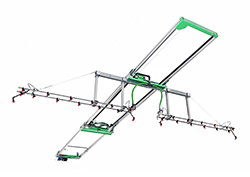Understanding Greenhouse Irrigation
Greenhouse irrigation involves the application of water to plants in a greenhouse setting. Unlike open-field irrigation, greenhouse irrigation is highly controlled, allowing growers to tailor water delivery to the specific needs of their plants. Effective irrigation is vital for maintaining optimal soil moisture levels, preventing water stress, and promoting vigorous growth.
Types of Greenhouse Irrigation Systems
Drip Irrigation: Drip irrigation is one of the most efficient methods for greenhouse watering. It delivers water directly to the plant roots through a network of tubes and emitters. This method minimizes water wastage and reduces the risk of fungal diseases by keeping foliage dry. Drip irrigation is ideal for a variety of crops, from vegetables to ornamentals, and allows for precise control over water application.
Sprinkler Irrigation: Sprinkler systems mimic natural rainfall, distributing water evenly over the plant canopy. These systems are versatile and can be used for both overhead and under-canopy watering. While sprinklers are effective for larger greenhouse setups, they may lead to higher humidity levels, which can encourage disease if not properly managed.
Micro-irrigation: Micro-irrigation, including micro-sprinklers and micro-bubblers, provides a balance between drip and sprinkler systems. It offers targeted water delivery with broader coverage, making it suitable for crops with varying water needs. Micro-irrigation systems are particularly useful in greenhouses with diverse plant species.
Ebb and Flow Systems: Ebb and flow, or flood and drain systems, involve periodically flooding the plant trays with nutrient-rich water and then allowing it to drain away. This method is highly efficient in delivering nutrients directly to the roots and is commonly used for hydroponic and aquaponic greenhouse operations.
Benefits of Greenhouse Irrigation
Water Conservation: Greenhouse irrigation systems are designed to optimize water usage. By delivering water directly to the roots and minimizing evaporation, these systems ensure that plants receive the necessary hydration without wastage. This is particularly important in regions with limited water resources.
Improved Plant Health: Consistent and precise watering promotes healthy root development and reduces plant stress. Adequate moisture levels prevent wilting and nutrient deficiencies, leading to robust and productive plants.
Disease Prevention: Controlled irrigation methods, such as drip and micro-irrigation, help keep foliage dry, reducing the risk of fungal diseases. By maintaining a balanced humidity level within the greenhouse, growers can prevent the spread of pathogens that thrive in damp conditions.
Enhanced Nutrient Management: Many greenhouse irrigation systems can be integrated with fertigation, the process of delivering nutrients through irrigation water. This ensures that plants receive a balanced supply of essential nutrients, promoting optimal growth and yield.
Labor Efficiency: Automated irrigation systems reduce the need for manual watering, saving time and labor. Growers can focus on other essential tasks, Greenhouse Fogging such as monitoring plant health and managing pest control, while ensuring that their plants receive consistent care.
Best Practices for Greenhouse Irrigation
Regular Monitoring: Even with automated systems, regular monitoring is essential. Check for leaks, clogs, and ensure that all parts of the system are functioning correctly. Adjust irrigation schedules based on seasonal changes and plant growth stages.
Soil Moisture Management: Use soil moisture sensors to monitor the water content in the soil. This helps prevent over- or under-watering and ensures that plants receive the right amount of moisture at all times.
System Maintenance: Clean and maintain irrigation equipment regularly to prevent buildup and ensure efficient water delivery. Replace worn-out parts to avoid system failures.






Comments